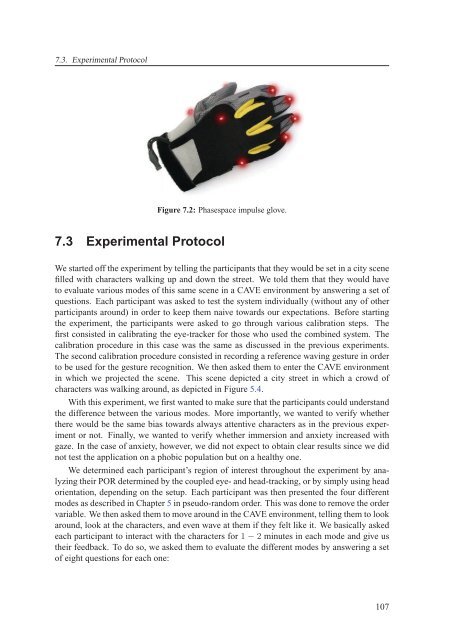Texte intégral / Full text (pdf, 20 MiB) - Infoscience - EPFL
Texte intégral / Full text (pdf, 20 MiB) - Infoscience - EPFL
Texte intégral / Full text (pdf, 20 MiB) - Infoscience - EPFL
Create successful ePaper yourself
Turn your PDF publications into a flip-book with our unique Google optimized e-Paper software.
7.3. Experimental Protocol<br />
Figure 7.2: Phasespace impulse glove.<br />
7.3 Experimental Protocol<br />
We started off the experiment by telling the participants that they would be set in a city scene<br />
filled with characters walking up and down the street. We told them that they would have<br />
to evaluate various modes of this same scene in a CAVE environment by answering a set of<br />
questions. Each participant was asked to test the system individually (without any of other<br />
participants around) in order to keep them naive towards our expectations. Before starting<br />
the experiment, the participants were asked to go through various calibration steps. The<br />
first consisted in calibrating the eye-tracker for those who used the combined system. The<br />
calibration procedure in this case was the same as discussed in the previous experiments.<br />
The second calibration procedure consisted in recording a reference waving gesture in order<br />
to be used for the gesture recognition. We then asked them to enter the CAVE environment<br />
in which we projected the scene. This scene depicted a city street in which a crowd of<br />
characters was walking around, as depicted in Figure 5.4.<br />
With this experiment, we first wanted to make sure that the participants could understand<br />
the difference between the various modes. More importantly, we wanted to verify whether<br />
there would be the same bias towards always attentive characters as in the previous experiment<br />
or not. Finally, we wanted to verify whether immersion and anxiety increased with<br />
gaze. In the case of anxiety, however, we did not expect to obtain clear results since we did<br />
not test the application on a phobic population but on a healthy one.<br />
We determined each participant’s region of interest throughout the experiment by analyzing<br />
their POR determined by the coupled eye- and head-tracking, or by simply using head<br />
orientation, depending on the setup. Each participant was then presented the four different<br />
modes as described in Chapter 5 in pseudo-random order. This was done to remove the order<br />
variable. We then asked them to move around in the CAVE environment, telling them to look<br />
around, look at the characters, and even wave at them if they felt like it. We basically asked<br />
each participant to interact with the characters for 1 − 2 minutes in each mode and give us<br />
their feedback. To do so, we asked them to evaluate the different modes by answering a set<br />
of eight questions for each one:<br />
107

















